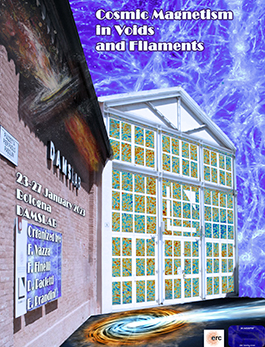Conveners
Wednesday
- Rafael Alves Batista (Radboud University)
Wednesday
- Elisa Prandini (DFA Padova)
There are several effects of large scale, cosmological magnetic fields which potentially could influence the 21 cm line signal. On the one hand primordial magnetic fields present since before decoupling influence the linear matter power spectrum. On the other hand due to the interaction with the cosmic plasma magnetic fields dissipate in the post recombination universe due to decaying MHD...
I will present a review of modern methods of topological data analysis and complex network analysis applied to the Cosmic web, formed by the large-scale distribution of matter. We will compare the advantages and disadvantages of both approaches and explore what new information and utilities can both of them bring to cosmological and extragalactic studies, compared to traditional cosmological...
Magnetic fields in galaxies and galaxy clusters are believed to be the result of the amplification of seed fields during structure formation. However, the origin of this intergalactic magnetic field (IGMF) remains unknown. Observations of high-energy gamma rays from distant blazars offer an indirect probe of the IGMF. Gamma-rays interact with the extragalactic background light to produce...
The Polarisation Sky Survey of the Universe’s Magnetism (POSSUM; https://possum-survey.org/) commenced in November 2022, and is using ASKAP’s unique survey capabilities to transform our understanding of astrophysical magnetic fields. POSSUM’s core goal is to produce a “rotation measure (RM) grid” of 30–50 polarised background sources per deg^2 over 20,000 deg^2 over 0.8-1.1 GHz. One of the...
Gamma-ray astronomy offers one of the keys to studying cosmic magnetism. Although gamma rays are zero charge messengers, their interaction with photons of the cosmic optical and infrared background produces pairs of charged particles. These multi-TeV electrons and positrons are sensitive to the magnetic fields present in cosmic voids, where gamma rays propagate ~3/4 of their journey from...
Intergalactic magnetic field (IGMF) is thought to be the weakest magnetic field present in the voids of large-scale structure in the Universe. Recently, Cherenkov telescopes have developed new measurement techniques to probe the presence and the properties of IGMF with gamma-ray observations. Gamma-ray bursts have been proposed as interesting targets for the detection of a secondary “pair...
The origin of the large-scale magnetic fields in the Universe is one of the long-standing problems in cosmology. To discriminate among the different explanations it is crucial to measure the intergalactic magnetic field (IGMF) in the voids among the galaxies. Gamma-rays coming from extragalactic sources can be used to constrain the IGMF due to their interaction with the intergalactic medium....

